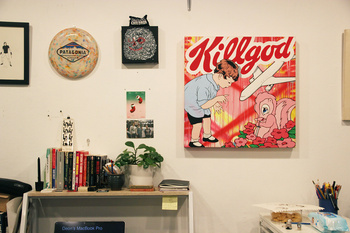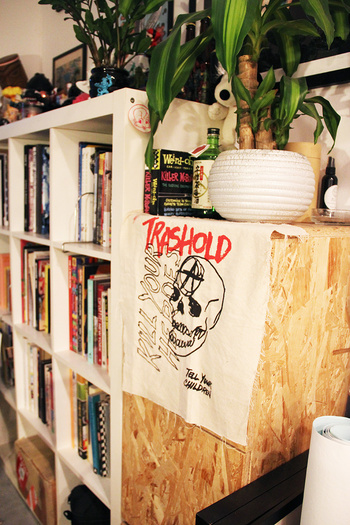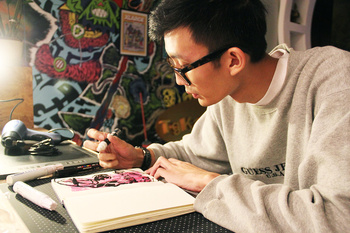A collection of conversations with a diverse range of local and regional creatives
Library Conversations for SGABF2020
We examined the systems that support art book making and independent art book publishing in Singapore and the region.
A Closer Look for SGABF2019
We gathered perspectives on our zine and art book culture, and discuss the possibilities of self-publishing today.
21 Creatives for SGABF2018
We sat down with 21 creatives of various disciplines to learn about their practice and asked each of them to fill up a blank page in a notebook.
SGABF: Tell Your Children (TYC) started out with a vision to serve as an artistic platform for explorations and collaborations with creative minds. Would you say that you have accomplished what you set out to do five years ago?
Deon Phua(DP): I think yes, we have used TYC as a base to work with different disciplines such as animations, fashion and music. Ever since we started TYC, we have accomplished quite a bit in terms of collaboration. We have a lot more to do but looking back, I think we have accomplished what we set out to do five years ago.
Since then, our vision has always been evolving so our visual and creative inspirations might change. The ideal state is to constantly be in this state of change. It is something that we can do because each of us brings different creative contributions and perspective on things, and we would help each other and figure out how can we learn and push each other’s creativity to the next level. We are always changing and evolving while fulfilling our creative passions.
SGABF: TYC has a distinct style that is almost like a signature – one can usually tell when a work is done by TYC. Did you start out with this style, or was it developed over time? As a collective, how does this “signature” work?
DP: Our current style definitely took a lot of trial and error. This style was not our plan when we had started out because like I said, we came together with the main purpose to help each other in our careers; we would post about each other’s art on social media, and support one another. We were trying to foster a sort of community between artists and illustrators, but when we started to work on projects together, it organically evolved into this style that people always refer to as ours. We are trying to move away from that now, and are in the midst of a rebranding to create a different, more updated, and refreshed look.
Coming up with a style is not easy because we have to think about how to make it cohesive. A lot of times, we would be figuring out whose drawings work and whose style the client likes — how Lydia’s lettering fits in with Russell’s character or Kevin’s inking; it is just a mix.
Even though the focus changes each time with different projects, somehow we always seem to achieve that distinctive aesthetic when everything is pieced together. So we really still do not know how it happened, maybe it is just a subconscious thing.

DP: There are pros and cons to both. As a group, our biggest strength is our greatest weakness. Coming together to work on different things is a strength because we have a wider range of contributions and creative perspectives. But it also becomes a weakness because we would have differing opinions with regards to a project and it would slow down its progress. It could also sometimes restrict what an individual can do because if there is something that one of us wants to try, but nobody else wants to do it, then it is just sian. [laughs]
So all of us have our individual work on the side because that is something that we take full ownership of; we can head it creatively and however we want it, and we do not need anybody else’s approval, I think that is the difference. Although you have each other’s support in a group, it can also be a hindrance if you are trying to pursue something personal. So we have to strike a balance between the two sides.
I still think that collaborative work is important. It is always good for creatives to push themselves, and multidisciplinary collaborations can really help them to take it to the next level. We are always thinking of how we can work with different creatives who are not just artists. Right now we are working with fashion to learn how to apply our skill set to something that we are unfamiliar with, but we can work with an expert in that field to create something that is "Wow".


Photo Credit: SGABF
SGABF: How is working as a collective different compared to working as an individual? In your opinion, do you think it is important to have more creatives engage in collaborative initiatives?
DP: There are pros and cons to both. As a group, our biggest strength is our greatest weakness. Coming together to work on different things is a strength because we have a wider range of contributions and creative perspectives. But it also becomes a weakness because we would have differing opinions with regards to a project and it would slow down its progress. It could also sometimes restrict what an individual can do because if there is something that one of us wants to try, but nobody else wants to do it, then it is just sian. [laughs]
So all of us have our individual work on the side because that is something that we take full ownership of; we can head it creatively and however we want it, and we do not need anybody else’s approval, I think that is the difference. Although you have each other’s support in a group, it can also be a hindrance if you are trying to pursue something personal. So we have to strike a balance between the two sides.
I still think that collaborative work is important. It is always good for creatives to push themselves, and multidisciplinary collaborations can really help them to take it to the next level. We are always thinking of how we can work with different creatives who are not just artists. Right now we are working with fashion to learn how to apply our skill set to something that we are unfamiliar with, but we can work with an expert in that field to create something that is "Wow".

Photo Credit: SGABF

Photo Credit: SGABF
SGABF: TYC has been commissioned by clients like Vans and Converse, and have even received commissions abroad. What are your opinions on the shift of the arts towards commercial work? In your practice, has commercial work stifled your tendencies towards experimentation, or does the collective still carve out time and space to work on your own inspirations?
DP: Maybe the reason why it seems like there are more opportunities for the arts to be used commercially is because clients are becoming increasingly receptive. Maybe about seven years ago, we might not be able to do what we are doing now, so I think we came in at the right time and place. This new openness is good for creatives because you can make your passions sustainable; commercial projects are required for us to pursue our own passions and interests. It is all about sustainability; we have lasted for four years, how can we last for another ten?
TYC has reached a point where we understand the difference between commercial work and our own personal need to experiment. So we would usually brainstorm a lot of ideas for clients, and if they don’t want to go with what we feel is better, we respect that because ultimately, they are the clients. We would just take the idea and do it as a personal project, so it doesn’t really stifle us. We do feel like more can be done sometimes, but we are not affected by it; there is a divide between commercial and our own work. With our clients, we are providing a service. We just have to ensure that both sides are happy, and most of the time, when our clients are happy, we are happy.
SGABF: In your opinion, what is the climate of the arts and culture in Singapore? How do you think fairs like the Singapore Art Book Fair can propel the climate of the arts forward?
DP: Art is becoming more widely accepted, but in terms of culture, Singapore is still lacking. Singapore has always been practical; we are always trying to figure out how we can use our skills and resources to make a career. But culture is more than that; culture should never be commercial. However, I do think culture will come when more creatives begin to be able to sustain their passions with their own creative pursuits. In many countries, say with skateboarding and graffiti, there are many subcultures that were born out of attitude and just doing something because they love it.
I think more Singaporeans should do things just because, and with no end goal.
When we first started, we tried looking for a collective in Singapore that we can emulate and learn things from. And we thought it was quite sad because the only one that we knew about was Phunk Studio. We had to learn most things ourselves because there was no mentorship. We do have friends in the industry who gave us pieces of advice, but there wasn’t someone that we could count on.
For me, I want to be that mentor to someone starting out in the industry. This culture of mentorship needs to be more active. Creative mentors are lacking. There are government programmes, but those are so sterile and rule-based, and just very “Singaporean”. They take something that is creative and make it very practical, but it needs to be more fun. Like having a group of creatives come together to have a meal and just have fun. We are planning to have some activities in our studio: get some friends together for a movie, play some nice music, and just chill. I don’t think we have enough of that here. We still have a long way to go in terms of culture.
I also wish there were more studios like ours that can collaborate. We open up our studio to be a co-sharing space, so we have a music studio and a design agency in the back. We would go out for meals, and when we have meetings with clients, sometimes we would just spontaneously invite one of them to join the meeting if we think that they can be involved in the project in some way. That is something that we definitely want to see more of.
Ultimately, I do believe that every creative outlet is good for the scene. For instance, the Singapore Toy, Game & Comic Convention and SGABF are all different outlets for creative people to showcase their works. Fairs like these lay the general foundation, and vendors should take it upon themselves to want to stand out and do something more to push their art and the scene. They should feel like it is a privilege to join these fairs, because how many people actually get to do that? It is also important for a fair to not be a platform where people feel meh about; it should be something that everybody wants to attend.

Deon Phua is a quarter of collective, Tell Your Children, which began as a shared vision between 4 creative individuals, Deon, Kevin, Lydia, and Russell.
Since its inception in 2014, the illustration studio has been constantly putting out work in the form of murals, key visuals, and events. From Baybeats Singapore to the Flatbush Zombies, TYC has always applied its signature visual direction across various projects, creating specific design solutions for its diverse range of clients. Through the years, TYC has also collaborated with other studios of different disciplines to create work that goes beyond the realm of illustration.
www.tycstudios.com
When we first started, we tried looking for a collective in Singapore that we can emulate and learn things from. And we thought it was quite sad because the only one that we knew about was Phunk Studio. We had to learn most things ourselves because there was no mentorship. We do have friends in the industry who gave us pieces of advice, but there wasn’t someone that we could count on.
For me, I want to be that mentor to someone starting out in the industry. This culture of mentorship needs to be more active. Creative mentors are lacking. There are government programmes, but those are so sterile and rule-based, and just very “Singaporean”. They take something that is creative and make it very practical, but it needs to be more fun. Like having a group of creatives come together to have a meal and just have fun. We are planning to have some activities in our studio: get some friends together for a movie, play some nice music, and just chill. I don’t think we have enough of that here. We still have a long way to go in terms of culture.
I also wish there were more studios like ours that can collaborate. We open up our studio to be a co-sharing space, so we have a music studio and a design agency in the back. We would go out for meals, and when we have meetings with clients, sometimes we would just spontaneously invite one of them to join the meeting if we think that they can be involved in the project in some way. That is something that we definitely want to see more of.
Ultimately, I do believe that every creative outlet is good for the scene. For instance, the Singapore Toy, Game & Comic Convention and SGABF are all different outlets for creative people to showcase their works. Fairs like these lay the general foundation, and vendors should take it upon themselves to want to stand out and do something more to push their art and the scene. They should feel like it is a privilege to join these fairs, because how many people actually get to do that? It is also important for a fair to not be a platform where people feel meh about; it should be something that everybody wants to attend.

Photo Credit: SGABF
Deon Phua is a quarter of collective, Tell Your Children, which began as a shared vision between 4 creative individuals, Deon, Kevin, Lydia, and Russell.
Since its inception in 2014, the illustration studio has been constantly putting out work in the form of murals, key visuals, and events. From Baybeats Singapore to the Flatbush Zombies, TYC has always applied its signature visual direction across various projects, creating specific design solutions for its diverse range of clients. Through the years, TYC has also collaborated with other studios of different disciplines to create work that goes beyond the realm of illustration.
www.tycstudios.com
© Singapore Art Book Fair 2025. All rights reserved.
For further enquiries, please contact us at info@singaporeartbookfair.org.
Singapore Art Book Fair is organised by
![]()
For further enquiries, please contact us at info@singaporeartbookfair.org.
Singapore Art Book Fair is organised by

